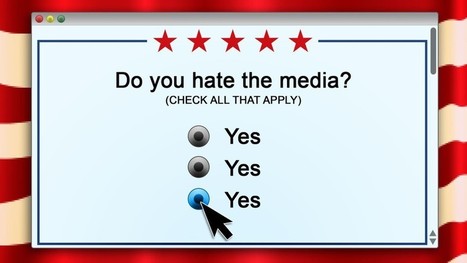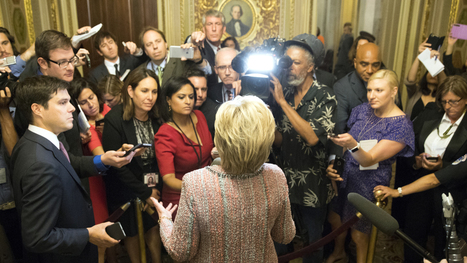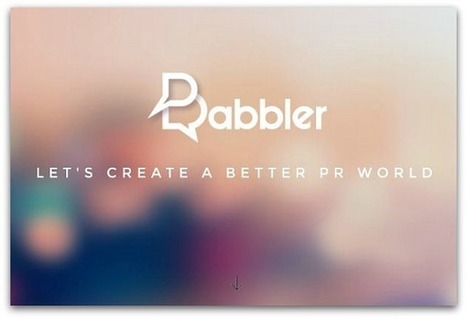 Your new post is loading...
 Your new post is loading...
Just moments after President Donald Trump's surreal, whirlwind press conference came to a close Thursday, the Trump campaign sent out a very strange email. The email posits that the media is an enemy that must be deflected, inviting recipients to take a survey about how much they hate CNN, MSNBC, Fox News and all mainstream media. "Instead, you — the American people — are our last line of defense against the media’s hit jobs." But there's more. As if to drive the point home with the hammer of Thor, the 25 questions are branded "the Mainstream Media Accountability Survey."...
Congratulations, US media! You’ve just covered your first press conference of an authoritarian leader with a deep disdain for your trade. Here are some tips from Russia.Vladimir Putin’s annual pressers are supposed to be the media event of the year. They are normally held in late December, around Western Christmas time (we Orthodox Christians celebrate Christmas two weeks later and it’s not a big deal, unlike New Year’s Eve). Which probably explains why Putin’s pressers don’t get much coverage outside of Russia, except in a relatively narrow niche of Russia-watchers. Putin’s pressers are televised live across all Russian TV channels, attended by all kinds of media — federal news agencies, small local publications and foreign reporters based in Moscow — and are supposed to overshadow every other event in Russia or abroad. These things are carefully choreographed, typically last no less than four hours, and Putin always comes off as an omniscient and benevolent leader tending to a flock of unruly but adoring children. Given that Putin is probably a role model for Trump, it’s no surprise that he’s apparently taking a page from Putin’s playbook. I have some observations to share with my American colleagues. You’re in this for at least another four years, and you’ll be dealing with things Russian journalists have endured for almost two decades now. I’m talking about Putin here, but see if you can apply any of the below to your own leader....
In a reply to a publicist who contacted me recently on some subject or another, I surprised even myself when I wrote to her that I could not take up her pitch because she used the phrase “reaching out” in her email.
If memory serves, I actually went so far as to tell her it is my policy to say no to pitches in which the phrase “reaching out” or any of its variants is applied. It was a ridiculous, ornery reply to a well-meaning request for coverage, for which I apologize.
However, the “reaching out” phrase rankled me, and I am trying to figure out why. One reason is its overuse. This phrase -- “reaching out,” “reach out,” “reached out” or whatever form it takes -- is certainly overused in the p.r. biz today (and in many other places too)....
You’ve just delivered the perfect media response. Your answer is on message and perfectly quotable. It will accomplish everything you had hoped.
Then…you say more.
It pains me to see an answer that was brilliant in its first 15 seconds become diluted when it lasts for another minute. An extended answer also risks introducing secondary and tertiary points that offer reporters the ability to quote something relatively unimportant. And sometimes, those unnecessarily long answers lead to a “seven-second stray,” an off-message line that becomes your only quote from the interview.
When I see our trainees deliver a great answer—and then keep going—I tell them this: “When you score a touchdown, get off the field!”...
Marketers and public relations professionals can find plenty of advice on how to write a press release, but rarely is that advice directly from the journalists that press releases attempt to engage.
It turns out, journalists have a lot to say about press releases. It also turns out that marketers have a lot to learn.
Although I recently joined an inbound marketing agency, I'm a 25-year veteran the Chicago Sun-Times and the Contra Costa Times, among other. For decades I started my mornings weeding through the press releases in my inbox, one finger hovering over the "delete" key and ready to strike.
Wondering whether things have gotten better lately, I reached out to several journalist friends.
"Most of what I get is garbage," said Mary Pols, a longtime Portland Press-Herald/Sunday Telegram reporter who has also worked at the Los Angeles Times.
Ouch.
Follow these top 9 recommendations to stand out....
The prevailing wisdom in PR has been that you should keep hammering away at the key messages you're trying to get across in a media interview, no matter what.Is the reporter asking you a completely unrelated question? Doesn't matter—repeat your key message. Do they want to speak to you about an issue or topic your key messages don't even cover? Doesn't matter—repeat your key message.Is the interview a fairly relaxed conversation about your company's strategy, rather than a reputation-destroying crisis? One size fits all—just repeat your key message.If you do this enough, this line of PR thinking goes, your points will stick and the reporter will repeat them. The industry even gave this approach a name of its very own: "block (the reporter's actual question) and bridge (to your key message)." Great—except it rarely works....
Yesterday, Tribune Publishing, purveyor of news since 1847, changed its name to “tronc” (short for “Tribune Online Content.”) It’s now a “content curation and monetization company” — a company that makes money from content, what we used to call a media company. Today, I deconstruct the rest of its attempt to use techno-drivel to misdirect our attention from its problems. Crisis-tossed Tribune Publishing, which owns the Chicago Tribune, the LA Times, and dozens of other papers, has suffered through a sale to a billionaire, a bankruptcy, a corporate split, newsroom turmoil, massive layoffs, and an unsolicited takeover offer. Now, as “tronc,” the company wants to be considered alongside Silicon Valley startups. (If this trend catches on, will the Boston Globe company become “hubstuff” and the New York Times “gray_lady”?) The tronc press release is a classic, because it reveals that when a media company wants to reinvent itself as a technology company, it drapes its press release in the same techno-drivel that tech companies use. Instead of meaningless media and corporate bullshit, we get meaningless, shiny Silicon Valley bullshit. It’s a transformation (you can tell because the release mentions “transform” or “transformation” six times).In the commentary below, I’ve added bold to indicate passives, meaningless superlatives, and especially, new-age jargon. I add commentary in brackets and commonsense translations below each section....
Journalists often speak of their interest in covering trends, and tying your clients to larger issues in the news can be a fruitful tactic. This was probably the thinking when I received a press release about a Pennsylvania hospital’s efforts to “go green.” Normally, it would have gone straight to the delete bin, but since I’m originally from the Keystone State and have some interest in green business practices, I gave the email an extra look. It turned out to be from a company that had just signed a contract to supply the facility with biodegradable trash bags. Now, I’m all for using eco-friendly materials, but the press release made it sound as if the place had just built a new emergency room from recycled bean sprouts: “We’re delighted that such a prominent institution recognizes the contribution [our product] can make to reduce the environmental impact of its daily operations. Our commercial product can be tailored for all kinds of applications and offers an important way for health care facilities, which by necessity generate large amounts of waste, to do the right thing for our environment.” Fast forward. An email arrived from a PR firm in Arizona promising an expert who could discuss hospitals’ efforts to improve “the patient experience.” The expert, I learned, is the CEO of a company that makes patient gowns. Let’s set aside the fact that both emails were woefully off-target (I’m actually sort of grateful, because they provided nice material for a column). What they have in common is that many folks would charitably call them a “stretch.” Both cited legitimate trends, but each was missing a key ingredient: A newsworthy (or quote-worthy) client....
The Republican frontrunner met with the editorial board on Monday morning. The full transcript follows at the link above: FREDERICK RYAN JR., WASHINGTON POST PUBLISHER: Mr. Trump, welcome to the Washington Post. Thank you for making time to meet with our editorial board. DONALD TRUMP: New building. Yes this is very nice. Good luck with it. RYAN: Thank you… We’ve heard you’re going to be announcing your foreign policy team shortly… Any you can share with us? TRUMP: Well, I hadn’t thought of doing it, but if you want I can give you some of the names… Walid Phares, who you probably know, PhD, adviser to the House of Representatives caucus, and counter-terrorism expert; Carter Page, PhD; George Papadopoulos, he’s an energy and oil consultant, excellent guy; the Honorable Joe Schmitz, [former] inspector general at the Department of Defense; [retired] Lt. Gen. Keith Kellogg; and I have quite a few more. But that’s a group of some of the people that we are dealing with. We have many other people in different aspects of what we do, but that’s a representative group....
PR Newswire has advised our clients to include images and video in their press releases for a number of years, and we are now seeing a much greater usage than previously. In 2015, 42% of releases included visual elements.
This is a sharp increase from the mere 14% we saw the last time we analyzed these numbers in 2013; however, there is still room for improvement. When you look at last year’s 100 most viewed press releases, 68 included multimedia, a 42% increase compared to 2013’s top 100.
It’s clear that the use of multimedia in press releases is quickly becoming standard practice within the industry. With the continued influx of visuals across the larger communications landscape, I expect these numbers to continue to climb....
As President Xi Jinping continues his crusade against corruption in China, we're learning how high the rot reaches into the ranks of the Communist Party. Yet amid the headlines about avaricious officials and unsavory ties between senior party leaders and moneyed interests, stories about the pervasive workaday ethical challenges are often lost. One example of relevance to marketers is the practice of paying for editorial coverage.
The most common form of this practice is the "transportation fee" paid to reporters in return for conducting an on-site interview, or for participating in a press conference. Fees hover around RMB ¥300 (about $50), and are given to the reporter in a red envelope inserted inside a press kit. However, it's worth noting that sums as high as ¥3,000 (approximately $500) are sometimes paid.
Knowledge of these practices within companies varies. For some, these fees are discreetly buried within other payments they make to outside agencies. For others, it's understood to be a "cost of doing business." Justification includes the argument that everyone does it, including multinational brands and big PR agencies; that getting media coverage without it would be impossible; and that Chinese journalists actually need the money because their salaries are so low....
Since its launch in 2011, the Taste blog has become a crucial piece of the marketing efforts at General Mills—from helping the company break big news to highlighting its emphasis on corporate sustainability.
“We wanted to use the blog to tell the stories we wanted to tell—the ones the media wasn’t picking up on or that we wanted to give some attention to,” said Kevin Hunt, who founded the blog and acts as GM’s corporate social media manager.
“Our team looked at it as a way to keep consumers and journalists up to speed on what’s going on across General Mills. In many instances, Taste gives journalists a reason to pick up the phone and call us.”
In the case of the new HefeWheaties beer, Hunt published an articleon the blog about the product on August 12. Within a day, it had already led to placements in national media outlets like NPR,Fortune, and NBC News....
Even the most experienced of us, can still learn a thing or two about pitching the press more effectively. I myself find that in the art of pitching, there’s definitely a continuous process of learning to refine the pitch and deliver the message in the best way possible.
With that thought in mind, as a side project, my colleagues and I have created a site entitled, “How To Pitch Me” that aims to help those who strive to pitch reporters in today’s tech landscape. Every week, we upload a Q&A submission by a different writer that will help folks understand how to become more skilful in pitching.
While reading these various submissions, I have noticed that there are certain tips that repeatedly come up. These pointers have also been shared with me by many writers in the past nine years that I have been doing public relations work. I decided to compile all these insights into one post that will be truly valuable for The Next Web’s community looking to gain insight on how to pitch right. Here are the top ten pointers:...
|
This drives journalists nuts. They feel a duty to rebut lies, and in the age of “John Oliver Destroys Something” headlines, there’s an appetite among liberal viewers for plucky correspondents eviscerating right-wing ideologues on-air. We’ve now seen one host after another—Todd, Cuomo, Anderson Cooper—lose his cool or waste a long interview trying to make Conway acknowledge elementary facts.
Of course, presidential flacks have always tried to stretch or shade the truth during on-air interviews. In his first briefings as press secretary to President George W. Bush, Ari Fleischer juggled contrary rationales for tax cuts, that the government could afford them or that a weak economy needed them, using whichever argument seemed to fit the evidence presented. In his first briefings as press secretary to President Obama,
Robert Gibbs used the term “financial stability package” to mask the stench of corporate bailouts. Reporters understood that no matter what they asked, Fleischer would defend tax cuts and Gibbs would defend bailouts. But the president’s spokesman would generally try to reconcile the president’s agenda with the facts. And if he couldn’t, he would at least clarify the agenda. Conway brings none of that. She alters unwelcome questions, disregards the facts presented to her, and clarifies nothing. In part, that’s because Trump has no organized agenda. All he has is ego. So that’s what she fights for. She’s not there to persuade a skittish Republican senator to repeal the Affordable Care Act. She’s there to defend and avenge one man’s wounded pride....
Journalists are busy people. If you bring something to their attention that captures their imagination—or, more importantly, the imagination of their readers, listeners and/or viewers—it has a chance of being newsworthy. Newsworthiness is critical to gaining and keeping access to journalists. If you contact them with information of marginal value that wastes their time, barriers grow. And, each time you waste their time, access becomes harder the next time around. So, when deciding whether or not to contact the media about a story (or asking your public or media relations professionals to do so), the most important thing to ask yourself is: Is this newsworthy?...
Over the past couple of years, several popular websites have incentivized their writers with a compensation plan that sounds reasonable: If your stories generate more clicks, we’ll pay you more.
But think about the real-world implications of that for a moment. If a writer / aggregator / reporter / blogger (let’s shorten that to the acronym “WARB”) has a direct incentive to generate more clicks, do you think they’re going to go with a straightforward headline or a more sensational one? Do you think they’ll look to exploit inadvertent “mini gaffes” more than they otherwise might?
I want to be careful not to suggest that all WARBs with a financial incentive would sensationalize their reporting. Perhaps the needle of public interest and popularity can be threaded, in some cases, simultaneously. And this overall trend of writing with traffic in mind is far from new. But, even with all of those caveats, it’s yet another troubling trend that makes a spokesperson’s job that much more challenging.
You’ll find a few examples of this trend below. Some of the sites listed in these news articles have since gone defunct, while others may have subsequently altered their revenue models....
The TV media no longer conceal their disdain for Donald Trump’s ludicrous spinners. Jake Tapper raps Rudy Giuliani for defending Trump’s refusal to release his tax returns and chides Paul Manafort: “These things, just because you say them, they’re not true!” CNN’s Brianna Keilar takes Kellyanne Conway to task for insisting Trump did not mean to say he’d lock up Hillary Clinton. (“I’m talking about what your candidate is saying, which is more important than what you are saying about this. He is saying she has to go to jail. He is not talking about she has to stand and be judged. He is saying she has to go to jail.”) And practically everyone treats the hapless Jason Miller as a liar, a fool or both.
Bias? No, these TV journalists can no longer bear to pretend Trump’s people are saying anything resembling the truth and are annoyed they have to put them on air essentially to lie to the American people....
Political press conferences are pointless, and mostly about media showboating. This isn’t something reporters are supposed to admit. We’d all like more chances to see a potential presidential candidate on the hot seat. But these days, at these things, the heat isn’t on. I cringe at press conferences more than I learn from them, because they usually degenerate into shout-fests based on questions that are rarely designed to elicit any new information, but rather a response to the other party’s latest talking point. “Reporters ask questions not to get information, but to get a reaction,” Susan Milligan wrote in the Columbia Journalism Review last year. “And even with that strategy, they rarely succeed.” With social media, candidates don’t need to rely on reporters to convey their views. That in turn means that stories that break news are rarely produced by press conference. So why the ongoing obsession with press conferences? Could it have something to do with a need to justify the money being spent by mainstream news organizations to keep reporters on the campaign trail, versus the exclusive content they take away from that investment?...
Apparently, there are 4.6 of you for every one of me, and yet most of the time, I can’t get a call back from a communications person to save my life.
I am a newspaper reporter who covers county government, but my paper is fairly loose with beat restrictions, so I also write about a lot of random things that interest me (recent examples: the plight of the public-health dentist, employee retention rates in law enforcement).
Writing outside of my beat requires that I spend a healthy chunk of my daily reporting life reaching out to PR pros, the vast – vast – majority of whom refuse to communicate with me.
It happens often enough that I cringe when I have to contact a rep I don’t know, because it almost always results in me sitting at my desk moaning, “But I’m a nice person!” while staring at the phone and hitting refresh on my inbox. (You may notice those two stories above do not quote a representative from a state or national agency. This is not for lack of trying.)...
It can be difficult to get a news release approved internally—even without thinking about search engine optimization.
However, if exposure, disclosure or page views are your goals, you must heed content discoverability and make your release SEO-friendly.
A list of search engine violations and penalties shows ways your content can fail to attract attention online. This applies to all your owned media content—including your website and news releases.
What makes some releases more successful than others in terms of drawing traffic? They’re written with healthy SEO features. These successful news releases appeal to Google’s latest algorithm, which rewards high-quality, unique and non-spam content.
Follow these five simple steps to create releases that can rank high in search results....
Cision recently published its annual State of the Media Report, which I find to be one of the most valuable resources for understanding changes in news media environment. The report is jam-packed with information about the current news media environment and how most journalists prefer to work (particularly around areas like social media and working with media relations professionals). If media relations is part of your job, I highly recommend you review Cision’s report in detail. Of course, since I know how busy media relations professionals can be (and since I’m such a swell guy), I’ve gone ahead and done the work for you. I reviewed the report in detail, and turned the most interesting findings into an actionable set of nine media relations tips you can use to improve your results in 2016 and beyond. Enjoy!...
Something I’ve been thinking about a lot lately: Are we over-relying on media relations in PR?
I’m talking about the broader scope of PR here–media relations, content marketing, social media marketing, community relations, etc.
For many years, media relations has been one of the core aspects of PR.
But, a number of stats and reports lately (not to mention consumer behavior trends in general) have got me thinking: We may be well past the tipping point....
While many find the press release to be an antiquated and now inefficient method of delivering content, the truth is that the press release is far from dead.
There are many audiences online who still rely on press releases as key sources of information.
Be it tradition or its deep roots, they continue to be used, and by more than just public relations (PR) departments. Except nowadays, many different types of press releases serve many different purposes.
But if you’re interested in creating effective and relevant press releases for distribution, you’ll have to understand the history, its evolution in a growing content universe, and all of the options you have available to you.
Consider this a crash course in all things press release...
Previously available only in France, Babbler already boasts “300 customers worldwide and 5,000 reporters that use it everyday” in that country.
On Tuesday, the organization announced that it’s available to PR pros and reporters in the United States.
Here’s the selling point for the network, said via press release:
Babbler helps create, manage and engage media communities by providing them the best way to interact with their network of sources, content, and story ideas, all in one place....
BuzzFeed has cracked the code on how to attract an audience. This is a media property that regularly generates over 200 billion video views per month and over 50 million unique monthly visitors.
Thanks to BuzzFeed, the listicle has become de rigueur for those charged with owned media and social channels. Of course, it’s the BF algorithm — hey, the data says a story about Donald Trump’s barber would trigger clicks galore — that does the heavy lifting.
Call it storytelling by the numbers.
Still, we pay attention to BuzzFeed and periodically conduct our own experiments like predicting what would happen if the White House poached BF talent to extend its own publishing empire....
|



 Your new post is loading...
Your new post is loading...











![The State of Multimedia in Press Releases [Study + Infographics] | Public Relations & Social Marketing Insight | Scoop.it](https://img.scoop.it/nsfZonQLcnT6cFUuceChQjl72eJkfbmt4t8yenImKBVvK0kTmF0xjctABnaLJIm9)





















Trump really wants to know if his supporters hate the media as much as he does. I'm speechless!